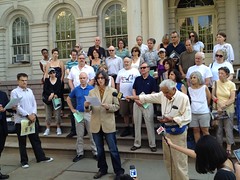A City Council committee voted in favor of New York University’s expansion plan on Tuesday following last minute negotiations that yielded several significant reductions of the project.
The land use committee’s 19-1 vote sends the plan, dubbed N.Y.U. 2031, to the full City Council, which will vote on the plans later this month. Councilwoman Margaret Chin, a member of the committee who represents Greenwich Village, took the lead in negotiations with the university and strongly urged other council members to support the modified plan.
“I wholeheartedly believe that this proposal will allow N.Y.U.’s growth in the Village to occur at a sustainable pace, and that it will not overwhelm the wider Village community,” Ms. Chin said. “Over the past few months, I have heard a litany of N.Y.U.’s broken promises from Village residents. It is time to start a new chapter.”
Typically, the City Council defers to the vote of the council member whose district includes the development under consideration.
But getting there took a number of sacrifices from N.Y.U., most notably the reduction of one of the boomerang buildings on the superblock south of Washington Square Park, which shrank from 11 stories to four. Both boomerang buildings will have smaller footprints that allow for more open space, and the separate towers of the Zipper building were modified to address concerns regarding loss of light.
Overall the City Council trimmed 212,000 square feet from the four buildings N.Y.U. plans to build, leaving the project with a little more than 1.9 million square feet of new space.
Other changes to N.Y.U.’s plans had more to do with community concerns than construction. Opponents had previously cried foul that the city would have had until 2025 to decide what to do with space N.Y.U. set aside for a public school. The deadline is now 2014, and if the city decides a school isn’t necessary, N.Y.U. said that it would provide 25,000 square feet of space there for the community to use, rather than take over the entire property.
More community space was also set aside in the Zipper building and in Washington Square Village, and the university said it would fast-track plans to build a new playground on Mercer Street and new seating on Bleecker Street in the project footprint.
At last month’s nine-hour public hearing, council members repeatedly criticized N.Y.U. officials for not maintaining the public spaces on the two blocks south of Washington Square Park. In response, N.Y.U. said it would create an endowment that would generate $150,000 annually to care for the private open spaces like the Sasaki Garden, and guarantee funding for the public ones.
The new retail space on the superblocks will also not be leased to bars or nightclubs.
After the vote, Ms. Chin told The Local that this morning’s negotiations came down to ironing out the legal details to guarantee the community facilities and the public school space. Ms. Chin said her ideal scenario would have been to eliminate both boomerang buildings, but she had to settle for a scaled-down plan.
“Obviously there are people who are upset, and we’re going to be sitting down with the leadership of the advocacy organizations and the community board,” she said. “It’s not over. There’s still a lot of room for community input.”
Though the committee’s other members, with the exception of Councilman Charles Barron, followed Ms. Chin’s lead in approving the project, many said they still have reservations. Councilmembers pressed N.Y.U. administrators on plans to maintain the open spaces, finance the project, and commit to hiring minority-, female-, and locally-owned construction firms.
“I have put in place strong checks and balances to ensure that N.Y.U. holds up its end of the bargain,” Ms. Chin assured her colleagues. “If N.Y.U. fails to do so, there will be consequences.”
The reductions did little to satisfy those opposed to the plan. Around two-dozen N.Y.U. faculty members and Village residents gathered on the City Hall steps this morning to present their own alternative plan, which they referred to as a “greenprint.” It revolved around a simple concept: no new buildings in Greenwich Village, but instead a re-purposing of N.Y.U.’s current space.
When the final vote was being tallied, the generally quiet meeting was interrupted. “You’ll kill the Village with your vote!” screamed one opponent. “Shame on you, Margaret,” another yelled. Andrew Berman, the executive director of the Greenwich Village Society for Historic Preservation, called the changes a “drop in the bucket” and vowed to fight on to convince other City Council members that the approving the plans would be a mistake. “Trimming the edges of this plan doesn’t solve the problem,” he said.
The concessions did little to diminish the university administration’s satisfaction, now that it is so close to the finish line after unveiling the project in 2010.
“What we’ve got here is still a lot of academic space to work with,” said Alicia Hurley, N.Y.U.’s Vice President for Government Affairs and Community Engagement. “You’re talking to an entity that’s never had 500,000 square feet of new space. This is still just under two million.”






